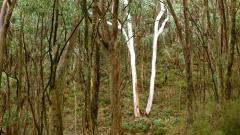
© donkeycart http://ow.ly/6OSeX
I don’t usually do this, but I’m going to blog about a paper I’ve just had accepted in the Journal of Plant Ecology that isn’t yet out online. The reason for the early post is that the paper itself won’t appear until 2012 in a special issue of the journal, and I think the information needs to get out there.
First, a little history – In May this year I blogged about a workshop that I attended at Sun Yat-Sen University in Guangzhou, China at the behest of Fangliang He. The workshop (International Symposium for Biodiversity and Theoretical Ecology) was attended by big-wig overseas ecologists and local talent, and was not only informative, but a lot of fun (apart from the slight headache on the way home from a little too much báijiǔ the night before). More importantly, we lǎo wài (老外) were paired with various students to assist with publications in progress, and I’m happy to say that for me, two of those have already produced fruit (one paper in review, another about to be submitted).
But the real reason for this post was the special issue of papers written by the invitees – I haven’t published in the journal before, and understand that it is a Chinese journal that has gone mainstream internationally now. I’m only happy to contribute to lifting its profile.
Given that I’m not a plant ecologist per se (although I’ve dabbled), I decided to write a review-like paper that I’ve been meaning to put together for some time now examining the state of Australia’s forests and the history of her deforestation and forest degradation. The reason I thought this was needed is that there is no single peer-reviewed resource one can turn to for a concise synopsis of the history of our country’s forest destruction. The stats are out there, but their buried in books, government reports and local-scale scientific papers. My hope is that my paper will be used as a general reference point for people wishing to get up to speed with Australia’s deforestation history.
The paper is entitled Little left to lose: deforestation and forest degradation in Australia since European colonisation, and it describes the general trends in forest loss and degradation Australia-wide, followed by state- and territory-level assessments. I’ve also included sections on plantations, biodiversity loss from deforestation and fragmentation, the feedback loop between climate change and deforestation, the history of forest protection legislation, and finally, a discussion of the necessary general policy directions needed for the country’s forests.
I’ve given a few titbits of the stats in a previous post, but let me just summarise some of the salient features here:
- Australian forests were by no means ‘pristine’ when Europeans arrived a little over 200 years ago – Aboriginal fire-stick farming had already changed the landscape substantially
- We’ve lost about 40 % of our total forest cover over the last 200 years
- Australia has only about 4 % of the world’s forests on about 5 % of the world’s total land area
- Remaining forests are highly fragmented, with some forest ecosystems now almost completely destroyed
- ~ 50 % of Australia’s forest have now been completely cleared or severely modified, with > 80 % of eucalypt forests in particular having been altered
- Most deforestation occurred originally in the most fertile coastal areas of NSW, VIC and SA. Later, government policies urged landholders to destroy vast swathes of forest land in WA, and most recently, in QLD
- QLD has the greatest area of native forest, but has had some of the highest deforestation rates in the world in the last 30 years
- TAS has the highest proportion of its land area covered in native forest (ACT has nearly the same)
- There have been hundreds of localised extinctions arising from deforestation and fragmentation around Australia
- There are around 2,000,000 ha of plantations (most exotic species) in Australia today
- Deforestation has increased droughts and temperatures, especially in WA
- The proportion of forests in Australia now falling within nature conservation reserves has increased from 11 to 16 % from 1998-2008, but much of this area has been previously cleared or severely modified
My main take-home policy recommendations are that existing tracts of native forest MUST be conserved first (given the irreplaceableness of primary forests), followed by a concerted effort to regenerate areas between existing native fragments to maximise the size of the latter.
If you’d like a pre-print copy, just let me know by sending a message through the ConservationBytes.com feedback/comment form. I’ll probably have to check with Fangliang if he’s happy for this, but I reckon it shouldn’t be a problem.
CJA Bradshaw



COMMENTS ( 1 )
posted on 07 October at 02:58
Some very valid reasoning …. Loved the article …. Surely increase in temperatures and frequency of droughts is being experienced all over the world as a direct impact of concrete jungles replacing the green ones …. Best from My Blogworld .... :)